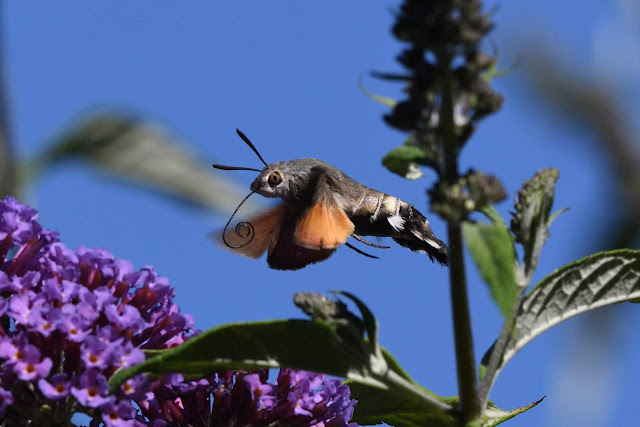Hummingbird Hawk Moth & Bee Hawk Moth........Natures wonders!
One of the most amazing creatures to watch, the Hummingbird and Bee Hawkmoths actually beat their wings faster than an actual Hummingbird!
The following photo's were all taken with my Nikon D500 and Nikon 70-200 f4, or 200-500 f5.6 lens.
Like its namesake, the Hummingbird Hawk Moth hovers in front of flowers, collecting sweet nectar from within. In place of a beak it has a long straw-like proboscis that it uses to siphon off the sticky fluid. At roughly an inch long this proboscis is nearly the length the moth’s body, so it keeps the appendage coiled up tightly when not in use.
The Bee Hawkmoth is from the same family as the Hummingbird Hawk Moth, but is easily distinguishable, by its brighter colouring and transparent wings.
Similar to other hovering insects, both generate lift by moving their wings in a shallow figure-eight pattern. This motion creates a spinning vortex of air on the upper surface of the wing, which generates a well of low pressure. The higher pressure zone below the wing essentially pushes the moth upward, keeping it airborne. Insect wings are relatively rigid, so they are less efficient at this mode of flight than either bird or bat wings. While hummingbirds can hover by generating around 50 wingbeats per second and bats about 17 beats per second, the hummingbird hawkmoth tops them both at 85 beats per second!
When watching a hummingbird hawk moth, you may get the impression that its eyes are following you. However, this is only an illusion. Like other insects, the eyes of the hummingbird hawk moth are made up of many tiny facets arranged in a roughly hemi-spherical pattern. Each facet contains a crystalline lens and a number of photoreceptor cells. This allows the moth to see in many directions at once, although in much less detail than the human eye. The dark spot that seem to follow your movement is actually a patch of facets absorbing most of the light coming from your direction. As you move relative to the moth’s eye, the patch seems to move, when in fact you are seeing a new patch of light-absorbing facets.
The hummingbird hawk moth prefers to feed in the bright daylight, so it’s eyes have developed some unusual features not seen in other moths. For example, the center of its eye is packed with more photoreceptors cells than the edges, allowing it to see more detail in the objects directly in front of it. This probably evolved to help the moth judge its distance from flowers, which are prone to bob and sway in the wind when the moth is feeding.
If you enjoy reading my photoblogs, please 'subscribe', or share them
by using the links at the top of the page.
To read my previous blogs, please use the 'Previous Blogs' link at the top, left of this page.
by using the links at the top of the page.
To read my previous blogs, please use the 'Previous Blogs' link at the top, left of this page.










The Broad-bordered Bee Hawk-moth (Hemaris fuciformis) really is a beatiful moth. We did not have many around in 2018 but the Humming Bird Hawkmoth was present in quite large numbers. Lovely photos Diane
ReplyDelete